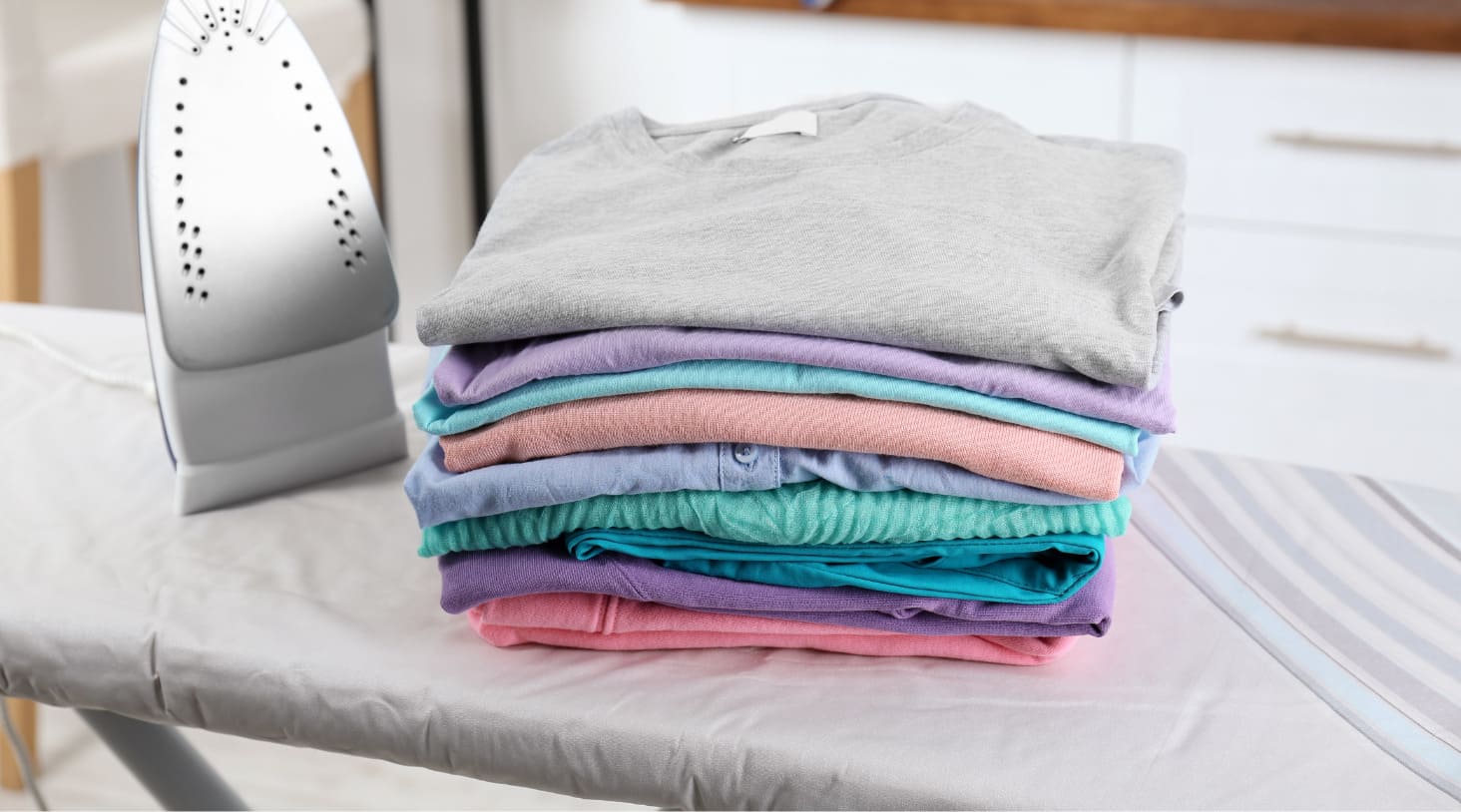Maintaining well-folded, neatly ironed and properly stored clothes not only enhances your wardrobe's appearance but also ensures that your garments last longer. Whether you're preparing for the week ahead or organizing seasonal attire, mastering these techniques will streamline your daily routine and preserve the quality of your clothing.
Folding Clothes
Proper folding techniques are essential for keeping your wardrobe organized and your clothes looking neat. Here's a detailed guide on how to fold different types of clothing to minimize wrinkles and optimize storage space:
T-Shirts and Tops
- Lay Flat: Start by laying the garment flat on a clean surface. Smooth out any wrinkles with your hands to ensure a crisp fold.
- Fold Sleeves: Fold the sleeves towards the center of the shirt to create a clean line along the sides.
- Lengthwise Fold: Fold the shirt in half lengthwise, bringing the bottom hem up to meet the collar. This creates a long, narrow strip.
- Final Fold: Depending on the size of your drawer or storage space, fold the strip in thirds or quarters. This method prevents excessive folding lines and makes it easier to stack shirts vertically.
Pants and Jeans
- Fold in Half: Lay the pants or jeans flat with the legs aligned. Fold them in half lengthwise, bringing one leg over the other.
- Fold Again (Optional): Depending on the length of the pants and the space available, you can fold them once more to reduce their size for storage. This method helps prevent creases and keeps pants organized in drawers or on shelves.
Dresses and Skirts
- Lengthwise or Thirds Fold: For longer garments like dresses and skirts, folding lengthwise is ideal to maintain their shape and minimize wrinkles.
- Storage Considerations: Store dresses and skirts flat or hang them on sturdy hangers to avoid crushing delicate fabrics and intricate details.
Benefits of Proper Folding
Wrinkle Prevention: Proper folding reduces the likelihood of wrinkles, saving you time on ironing and ensuring your clothes look fresh when you wear them.
Ease of Access: Neatly folded clothes are easier to locate in drawers or closets, making your daily routine more efficient.
Ironing Techniques
Ironing clothes effectively ensures a crisp, polished appearance. Follow these steps to master the art of ironing:
Prepare the Iron
Before you begin ironing, it's crucial to prepare your iron properly:
- Adjust Temperature: Different fabrics require different heat settings to prevent damage. Set your iron to low for delicate synthetics like polyester, medium for cotton and blends, and high for sturdy fabrics such as linen or denim. Always check the garment's care label for specific instructions.
- Water Reservoir: Fill the iron's water reservoir if it has a steam function. Steam helps relax fibers and remove wrinkles more effectively.
Ironing Order
To streamline your ironing process and achieve optimal results:
- Sort by Fabric Type: Start with garments that need lower temperatures to avoid scorching delicate fabrics.
- Sequence: Iron clothes inside-out when possible to prevent shine on delicate materials. Begin with items like t-shirts and lighter garments before moving on to heavier fabrics such as trousers or dresses.
Using the Steam Function
Activate the steam function as needed during ironing. Hold the iron slightly above delicate fabrics to allow the steam to penetrate without direct contact, preventing watermarks.
For hanging garments or drapes, use the iron's vertical steam feature. This method refreshes fabrics without removing them from their hangers, making it ideal for last-minute touch-ups.
Finishing Touches
- Cool Down: After ironing, allow garments to cool completely before hanging or folding. This prevents new wrinkles from forming.
- Hang Immediately: Hang ironed garments promptly to maintain their smooth appearance. For trousers, use a hanger with clips to avoid creasing at the knees.
Storing Clothes
Proper storage methods are crucial for preserving the shape, texture, and overall quality of your clothing over time. Here’s how to ensure your garments remain in excellent condition:
Hangers
Choosing the right hangers can make a significant difference, especially for delicate fabrics:
- Padded or Non-Slip Hangers: Use these for delicate fabrics such as silk or knitwear. Padded hangers help maintain the garment's shape without causing indentations or stretching.
- Avoid Wire Hangers: Wire hangers can leave creases and marks on clothes, particularly on shoulders and collars. Opt for sturdier options that provide better support.
Drawer Organization
Properly organizing your drawers keeps folded clothes neat and minimizes wrinkles:
- Neat Stacking: Fold clothes neatly and stack them horizontally in drawers. This method prevents excessive wrinkling and makes it easier to see and access items.
- Organize by Type: Separate clothes by type (e.g., socks, underwear, t-shirts) to streamline your daily dressing routine. Consider using drawer dividers or small baskets to further organize smaller items.
Seasonal Rotation
Rotating clothes seasonally helps manage wardrobe space and protect garments from damage. You can for exemple do off-season storage by storing clothes that are not in current rotation in vacuum-sealed bags or garment bags. These bags protect against dust, insects, and moisture.Clearly label storage containers or bags to easily identify the contents. This makes it simpler to retrieve specific items when the season changes.
Additional Tips
- Air Circulation: Allow adequate air circulation in your storage spaces to prevent musty odors and mildew buildup.
- Avoid Overcrowding: Avoid stuffing closets or drawers full, as overcrowding can lead to wrinkles and unnecessary wear on fabrics.
- Check Regularly: Periodically check stored clothes for any signs of damage or pests, especially before reintroducing them into your wardrobe.
By incorporating these folding, ironing and storage techniques into your clothing care routine, you can ensure that your wardrobe remains organized and durable. Taking a little extra time to properly care for your clothes not only saves you effort in the long run but also helps you make the most out of your wardrobe investments.



